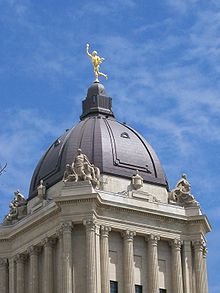Manitoba Legislative Building
Standing at 77 metres (253 ft) tall,[3] it was designed and built by Frank Worthington Simon (1862–1933)[6] and Henry Boddington III, along with other masons and many skilled craftsmen.
)[5] By 1909, Manitoba sought a larger and more impressive building for its legislature, considering the province's booming economy and population that had expanded sevenfold since 1881.
Of the 67 submissions, Frank Worthington Simon, a former student at the École des Beaux-Arts, had his design chosen for the construction of the impressive structure.
Such scandal inspired a royal commission calling to investigate the building’s construction, subsequently bring on the resignation of a Premier Rodmond Roblin and a change of government.
[5] Manitoba has every reason to be proud of her new Parliament Buildings at Winnipeg, for it is perhaps the most imposing structure in Western Canada and one of the most outstanding pieces of architecture in the whole Dominion.
Among others, the east and west ends of the North Wing had been closed in and occupied by the Comptroller-General, Game Guardian, Noxious Weeds Commissioner, and the Superintendent of Buildings and Moving Picture Censor Board.
On 4 October 1995, Governor General Roméo LeBlanc officially opened the Manitoba Plaza on the south grounds of the building, commemorating the 125th anniversary of the province.
In March 2015, a military hall of honour opened in the Legislative Building commemorating the Manitoba's regiments who fought World War I.
The Chamber floor was raised 76 centimetres (2.49 ft), front-row desks were moved forward to allow wheelchair access between the first two rows, and a ramp was installed on the opposition side of the house.
[5] Tyndall stone and marbles are used throughout the building, both including such fossils as sponges, gastropods (snails), cephalopods (mollusks), and trilobites.
[3] The building rests on 421 concrete caissons, which pass through 14 metres (46 ft) of glacial Lake Agassiz clays before hitting limestone bedrock.
In contrast, most of the statuary uses Bedford Limestone from Indiana, which is the oldest stone in the building, dating to slightly more than 2.5 billion years ago.
[4][5][11] On the north side of the Legislative Building, above the 6 Ionic columns, is the main pediment, the figures of which were designed by Scottish sculptor Albert Hemstock Hodge and carved by the Piccirilli Brothers of New York.
Describing its central figure as a representation of Manitoba, Frank Worthington Simon wrote of the pediment:[In the left hand corner,] Enterprise beckons the workers to the Land of Promise.
[12] On the outside of the building, at the four corners of the base of the dome are representations of Agriculture, Art, Industry, and Learning, designed by William Birnie Rhind of Scotland and carved by F. A. Purdy of Vermont.
Each pair guards a chest, rumoured to represent the Ark of the Covenant because of the proper proportions as mentioned in the ancient Hebrew texts.
Also in this area, facing the Assiniboine River, sits the sculpture of Louis-Riel, leader of Métis, created by Miguel Joyal.
[5]Each one of the four corners of the copper dome supporting the Golden Boy has a stonework grouping representing the four elements of alchemy, earth, air, fire and water.
[14] Flanking the steps are life-size North American bison, a symbol of the Province of Manitoba, meant to represent the sacred bulls that guard temple entrances.
Over the north entrance facing Medusa is the bust of Athena, Greek goddess of war, embodiment of democracy and also the protector of cities.
[14] These figures located on the third floor were carved by the Piccirilli Brothers of New York,[14] using models prepared by Albert Hodge of London, England.
[16] In the centre of the Rotunda is an Italian marble balustrade 4 metres (13 ft) across surrounding the Pool of the Black Star on the floor of the level below, a representation of the altars of the ancient Greeks.
Electric light fixtures around the circumference of the Pool of the Black Star have sea creatures on the base, and male and female heads just under the shade.
[5] Measuring 7.3 metres (24 ft) square, the room is in the Edwardian style, panelled in black American walnut, inlaid with ebony, and has a dentilled cornice and composite columns in each corner.
A French gilt chandelier hangs from the ceiling and a carpet, specially hand-woven in Donegal, Ireland, covers the floor.
[18] Electric light fixtures flanking the entrance to the chamber have sea creatures on the base, and male and female heads just under the shade.
Above the Chamber entrance is a mural by the British artist Frank Brangwyn, who described it as an allegory of the Canadian effort in World War I.
Among the figures represented are Justice, Knowledge, and Wisdom; Tolerance & Magnanimity; Fortitude, Prudence, & Temperance; and Faith, Hope, & Charity; as well as Mercy & Understanding, Courage & Vigilance, and Sacrifice & Loyalty.
[18] To the right of the speaker is a statue of Moses holding the Ten Commandments, to the left is Solon, a famous lawmaker of ancient Athens.
[18] Even as such changes have brought the assembly into modernity, the original inkwells employed by an earlier generation of Manitoban politicians are still visible.









